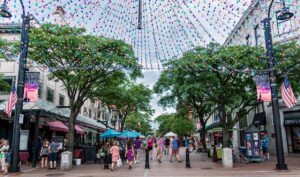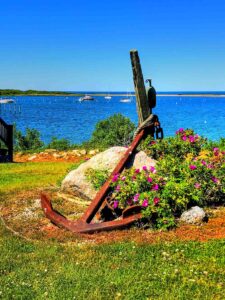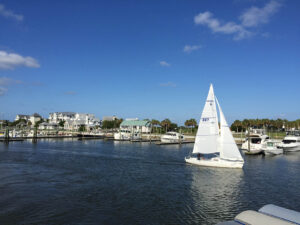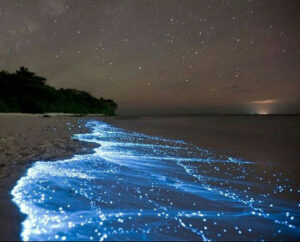Much has changed since 1608 when John Smith first explored the banks of the Patapsco River, whose tidal portion forms Baltimore’s harbor and flows into the Chesapeake Bay. From trading posts dotting the shores rose a thriving industrial giant in the 18th, 19th and first half of the 20th centuries. Along the way, the region defeated the British, ignited the Civil War, and was an international leader in shipbuilding, manufacturing and oystering. More recently, one of Baltimore’s most famous sons, Olympian Michael Phelps, showed the world just what a local boy could do in the water.
Today, Baltimore’s storied waterfront and its eclectic, historic neighborhoods are enjoying a renaissance.
Whatever your interest when anchored — fine dining and shopping, museums and culture, urban adventures and more — Charm City has it all. The nickname hails from a 1970’s marketing gimmick of distributing literal charms at various Baltimore landmarks. The campaign’s tchotchkes are long gone, but the name has stuck, a fitting moniker for a region known for its friendliness and unique charm.
Everything Old is New Again on the Baltimore Harbor
Sure, Baltimore’s most famous waterfront locale, the Inner Harbor, is approaching middle age — its marketplace, National Aquarium, and Maryland Science Center opened in 1980 — but it’s aging gracefully. The Harborplace Pavilions are getting facelifts this year. The National Aquarium’s newer exhibits, including Animal Planet Australia: Wild Extremes and the Living Shoreline add to the more than 20,000 species that call the state-of-the-art marine center home. Pier Six Pavilion summer concerts continue to draw national acts.
There are several places where history is permanently docked at the Inner Harbor. The restored USS Constellation, the last all-sail ship of the U.S. Navy, welcomes visitors. The storied tall ship was launched in 1797 from the nearby Harris Creek Shipyard in Fells Point. If you’re game for some actual stargazing after the USS Constellation, take a short walk to the nearby Maryland Science Center’s Observatory. The U.S. Coast Guards’ lightship Chesapeake, docked near the National Aquarium alongside the USS Torsk, a Naval submarine, and the USCGC Taney, the last ship floating that fought at Pearl Harbor, all welcome visitors.
Twenty years ago, Harbor East was a ghost town of vacant warehouses, just a stretch of waterfront and streets to pass through on the way from the Inner Harbor to Fells Point. Today, it boasts great shopping, dining, the Four Seasons Hotel and the Baltimore Marriott Waterfront, as well as Legg Mason’s headquarters. Shop at Brooks Brothers, J. Crew, Warby Parker and other national retailers, including the homegrown Under Armour Brand House. Baltimore boutiques such as the fashionista-favorite Sassanova and Curiosity are for high-end home goods.
Harbor East’s revitalization means several options for a memorable meal, beginning with the venerable Charleston where award-winning chef Cindy Wolf and Tony Foreman elevate Southern fare to an artform. Or try the Four Seasons’ dining options: Azumi, Wit & Wisdom Tavern, the Loch Bar and The Bygone. After a meal at Italian chophouse Tagliata, retire to The Elk Room, with a speakeasy-vibe, for live music, cigars and venison tartare.
Baltimore’s waterfront communities have long been home to generations of Polish-Americans and other ethnic groups. This Polish heritage is memorialized in Harbor East’s National Katyń Memorial, a massive, 44-foot statue — erected in remembrance of the victims of the 1940 Katyń massacre of Polish nationals. The waterfront’s many restaurants and cafes celebrate this ethnic heritage from Little Italy’s fare to Sophia’s Place in Fells Point.
President Street Station, between Inner Harbor and Harbor East and now the Baltimore Civil War Museum, has seen its share of history. The Maryland-born abolitionist and former slave Frederick Douglass escaped north via train, disguised as a sailor with papers claiming he was a free black seaman. President Abraham Lincoln traveled through Baltimore via the station’s secret passageway, clandestine maneuvers required by the first bloodshed of the Civil War in April of 1861.
The View from the Water
Baltimore offers several outstanding marina options, and thanks to the city’s expanded water taxi service, it’s easy to explore the waterfront neighborhoods by boat, day or evening. The view from on deck is particularly stunning at night. Don’t miss the lit-up Domino Sugars sign — the Eiffel Tower of Baltimore.
Step off the pier onto the cobbled streets of Fells Point and step back into the quaintness of an 18th-century shipping town, complete with taverns and cobblestoned streets –— and decidedly 21st-century coffee bars, antique shops and funky, one-of-a-kind boutiques. Named for William Fell, the Quaker Englishman who founded a shipbuilding company in 1726 that built the worldfamous Baltimore Clippers, Fells Point embraces its nautical past and is among the best preserved historic neighborhoods in the country.
The newest jewel of the Fells Point waterfront is the Sagamore Pendry Baltimore, a boutique hotel with 128 luxury guest rooms and suites and amenities galore, including a private dock, cabana-lined pool with panoramic views, the Rec Pier Chop House, and more. Located in the artfully restored Baltimore Recreation Pier, the Pendry’s pedigree is quintessential Baltimore.
Any stroll through the streets of Fells Point should include a trip to the Frederick Douglass-Isaac Meyer Maritime Park. Located in one of the city’s oldest existing waterfront industrial buildings, it’s also the site of the country’s first African-American owned and operated shipyard. The museum celebrates African-American maritime history and the life of Isaac Meyer, a free-born African-American. The museum is also home of the Living Classrooms Foundation, the nonprofit that operates Baltimore’s historic ships. Outside the museum is an imposing, much-larger-thanlife bust of Douglass. As a slave and young boy in Fells Point, Douglass learned to read and write. Later, he worked on the docks before fleeing north to freedom in 1838.
Grab a water taxi to Locust Point, home to some of the oldest rowhouses in the city, Under Armour’s headquarters, and Fort McHenry National Monument and Historic Shrine. It was here that prominent Washington, D.C., lawyer and Baltimore-born Francis Scott Key, aboard the British flagship HMS Torrant to negotiate a prisoner exchange, watched the British bombard Fort McHenry during the Battle of Baltimore in September of 1814.
The poem he penned, while watching the rockets’ red glare was later set to music and became “The Star-Spangled Banner.” Travel north to Baltimore’s elegant Mt. Vernon neighborhood to the Maryland Historical Society Museum and Library to view the oldest known surviving manuscript of “The Star-Spangled Banner.” If you visit Camden Yards for a Baltimore Orioles’ game, sing it like a local and shout “O” during the anthem’s “Oh, say does that star-spangled banner yet wave.”
Federal Hill, near the Inner Harbor, is a haven for history buffs, retail fans, and those with an appetite. Filled with galleries, boutiques, cafes and live-music venues, it’s also home to Cross Street Market, an indoor food market in the heart of Federal Hill. It is part of the city’s public market system, the oldest continuously operating public market system in the U.S. It’s a great joint to grab barbecue, a deli sandwich, and naturally, a crab cake.
The neighborhood gets its name from the imposing hill overlooking the Inner Harbor. Long a gathering place, the hill got its name from the ending point of a rousing parade in 1789 following the ratification of the new “Federal” Constitution of the United States. The cannon, which sits atop the hill, was placed there in 1861 by Union troops to make clear Maryland’s allegiance during the Civil War. Climb to the top for a great view of the water and of the many luxury condominiums being built in the neighborhood.
Whiskey devotees will enjoy a water taxi trip to Port Covington to tour the Sagamore Spirit Distillery and drink in the history of Maryland’s Rye Whiskey. Afterwards, enjoy a meal of local fare and sustainably raised Maryland seafood at the Rye Street Tavern. Once a vast railroad terminal with coal, grain and merchandise piers, Port Covington, abandoned 30 years ago is now one of the country’s largest urban renewal efforts with its 235-acre, mixed-use development and restored waterfront.
Water taxi’s aren’t the only way to see the waterfront. Grab a bottle of wine and some Maryland oysters and charter a sail aboard Captain H.M. Krentz’s restored skipjack. At the turn of the 20th century, nearly 2,000 skipjacks navigated the shallow waters of the Chesapeake to dredge oysters. The single-masted rig was perfect for continuous licks over the Bay’s then-many oyster beds. Today, about 30 skipjacks remain with only a few still oystering, the last commercial sail-powered fishing fleet in North America.
If you prefer a stroll, walk the seven-mile Waterfront Promenade from Fort McHenry to the Canton Waterfront. Mostly hugging the shoreline of the waterfront neighborhoods, the paved path meanders past marinas, landmarks, ships and storefronts.
Baltimore’s Quirks and Perks
Being quirky is a matter of civic pride in Baltimore. This is, after all, the birthplace of musician Frank Zappa, filmmaker John Waters, literary curmudgeon H.L. Mencken and the Ouija Board. And it was where Edgar Allan Poe chose to finish out his last days.
Embrace the eclectically charming and out-of-the-ordinary at The American Visionary Art Museum in Federal Hill. Dedicated to self-taught outsider art, the museum has a popular outdoor summer film series, Flicks on the Hill.
Little Italy, nestled next to the Inner Harbor and Fells Point neighborhoods, boasts great restaurants and the wonderful Little Italy Open Air Film Festival. Free and open to the public, films are projected onto the wall of Ciao Bella Restaurant in the Da Mimmo Ristorante parking lot. Don’t forget to pick up cannolis at Vaccaro’s Pastry Shop after a meal at La Scala and a round of bocce ball on La Scala’s indoor court.
Brunch on Sunday morning is standard fare when traveling, but Baltimore puts the charm into this culinary chestnut. Stroll the Baltimore Farmer’s Market & Bazaar, for a pit beef sandwich, homemade donut, and more. Miss Shirley’s in the Inner Harbor puts a crabby twist on all things breakfast-related. The Blue Moon Café, with locations in Federal Hill and Fells Point, serves a self-proclaimed “bad-ass breakfast,” which includes the not-necessarily- maritime-themed Captain Crunch French Toast.
A trip to Baltimore is not complete without steamed Blue Crabs, especially in late summer when crabs are sweet, heavy and plentiful. Survey a few locals for their favorite crab house and you’ll get a dozen different answers. You can’t go wrong with steamed crabs from Bo Brooks, Captain James Seafood Palace or Nick’s Fish House.
WHERE TO DOCK
- HarborView Marina 410-752-1122
- Baltimore Marine Centers at Inner Harbor 410-837-5339
- Baltimore Marine Centers at Lighthouse Point 410-675-8888
- Crescent Marina at Fells Point 443-510-9341
- Henderson’s Wharf Marina & Inn 410-732-1049
- Baltimore Yacht Basin 410-539-8895
- Tidewater Yacht Service 410-625-4992
- Harbor East Marina 410-625-1700 Celebrate the grand opening of the marina upon completion of stage two renovations (June 8, 2018).
WHERE TO STAY
- Sagamore Pendry Baltimore (1715 Thames St.)
- Four Seasons Baltimore and Residences (200 International Drive)
- The Baltimore Marriott Waterfront Hotel (700 Aliceanna St.)
EVENTS
- Light City Baltimore – This three-year-old festival illuminates the waterfront and much of downtown with interactive light displays and live music (April 18-21, 2018).
- Baltimore Kinetic Sculpture Race – The American Visionary Art Museum hosts a land and water race of dozens of human-powered works of art (May 5, 2018).
- 143rd Preakness Stakes – Part of the Triple Crown, the 143rd Preakness Stakes is held on the third Saturday in May at the Pimilco Race Course (May 19, 2018).
- Pier Six Concerts – The 2018 season begins the first week of June at the Inner Harbor music venue. This summer’s lineup includes rock, indie bands, jazz and hip-hop. TrawlerFest Baltimore Make your way to Harbor East Marina for PassageMaker’s standalone boat show specifically designed for cruising-under-power enthusiasts. Purchase discounted tickets at trawlerfest.com with promo code: MARINALIFE. (September 26-30, 2018).
- Fells Point Fun Festival – Celebrate the festivals 51st year — featuring live music and local vendors (October 13-14, 2018).
GETTING AROUND
- Baltimore’s Water Taxi – Offers stops throughout the waterfront neighborhoods.
- Baltimore Bike Share – Download the Baltimore Bike Share app to find rental stations throughout the city.





